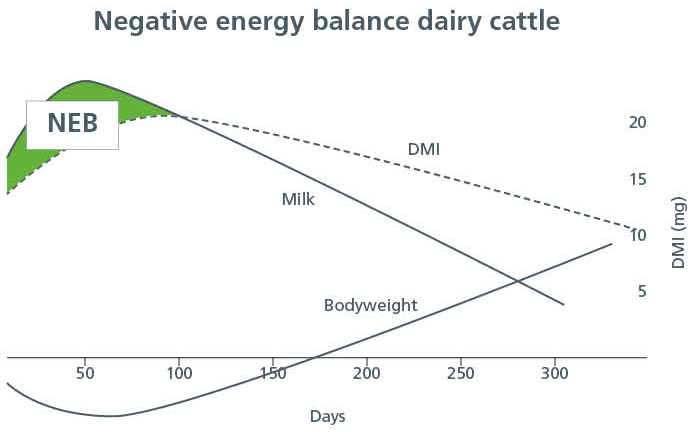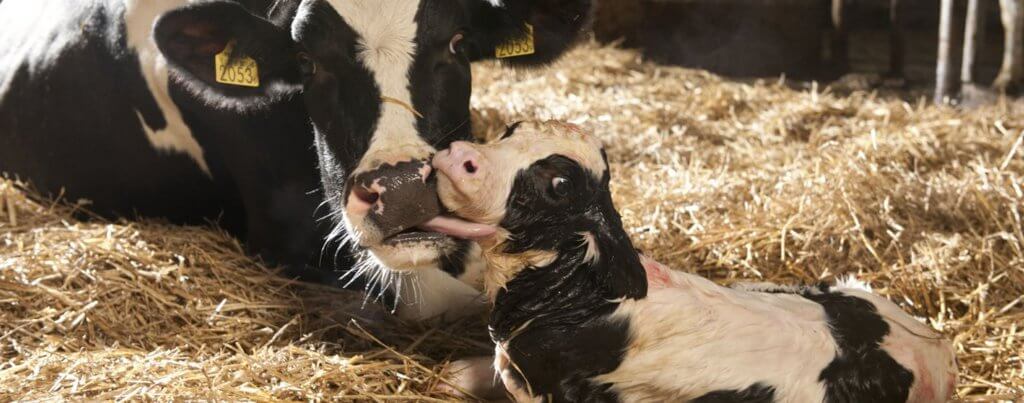On to the next lactation
Increasing the lifespan of your dairy cows is paying off. From three to five lactations yields between 25,000 to 37,000 euros for an average farm with 100 dairy cows. Most dairy cows are replaced in the first two months after calving. Premature culling is mainly due to fertility problems, infections, and claw health issues.
By paying specific attention to animals at risk, dairy cows have a larger chance to start their next lactation without problems. After the transition period, a calmer phase starts, but diseases and health issues remain a threat for animal health and performance. Examples include ketosis, mastitis, fertility issues, and claw problems. Also, proper nutrition, optimal rumen function and good feed efficiency are important during lactation. We aim at a dairy cow that easily conceives, sustains pregnancy and finishes lactation flawlessly.
Transition diseases and lactation
Transition problems around lactation start are closely interrelated. It often starts with a low Ca level in the blood. A calcium shortage may trigger other health problems after calving.
A low Ca supply directly affects muscle function in the animal, and this compromises all processes that rely on proper muscle functioning, like rumen contraction and feed intake, uterus contraction at calving, but also the closure of the teat tip. It is important to restore the Ca and energy levels of the animal as soon as possible. A lack of energy at lactation start also negatively affects insemination results: Cows show less oestrus symptoms, they are listless, and also the egg quality declines.
Claw problems are the third main reason for premature culling of dairy cattle. Consequences of suboptimal claw health include decreased feed intake, decline in milk production, infections, and increased calving intervals. Problems may be prevented by supplying a hoof bolus, containing biotin, zinc and vitamin E, required for hoof formation and proper functioning of enzymes that regulate keratin formation.
Mastitis
At the beginning of the lactation, cows suffer from an increased risk of mastitis, caused by insufficient calcium and energy supplies. A lack of Ca causes decreased muscle function, leading to slower closing of the teat tip after milking. A lack of energy affects the immune system, thereby increasing the risk of infectious diseases, like mastitis.
In many cases, an allicin bolus (Topro Udder bolus) is used to combat subclinical mastitis. Allicin, a component of garlic, has anti-microbial properties against yeasts, fungi, bacteria, viruses and protozoa.
Ketosis
Ketosis is often seen in dairy cattle. Research shows that at least one cow out of ten suffers from subclinical ketosis in the first two months after calving. Ketosis is caused by an negative energy balance (see Figure 1), because the cow starts producing large quantities of milk, while the feed intake is insufficient to supply the required amount of energy.
Cows in negative energy balance mobilise energy from their bodily fat reserves. In this process, ketone bodies (acetone, beta-hydroxy-butyric acid) are formed. The body is able to process small quantities of these ketone bodies, but higher quantities are stored in the body. Cows suffering from ketosis become slow and listless, have reduced appetite and consume inadequate amounts of concentrates. The milk production declines, the manure becomes thicker and the cow’s condition score decreases.
Also, the animals become more susceptible to other health issues, like metritis and displaced abomasum. Severe cases of ketosis may be recognized through a characteristic acetone smell of the exhaled breath. When cows are at risk of developing ketosis, it is important to increase their energy intake and counteract the negative energy balance. To do this, products may be applied that are palatable, stimulate feed intake, and contain energy sources that are gradually released in the metabolism. KetoCare is an excellent example of such a product.

Schematic representation of negative energy balance dairy cattle
Nutrition
The importance of an adequate energy supply is clear. Also, trace elements play an important role in fertility. A shortage of trace elements – like iodine, copper and selenium – has direct and in direct negative effects on fertility. This also applies for some vitamins, mainly related to their role as antioxidant.
Feed efficiency is an increasingly important parameter in dairy farming. It tells you how much milk is produced from one kg of dietary dry matter. To a large extent, this parameter determines the profitability of a farm. Your dairy cows can only produce efficiently when their vitamin and mineral metabolism is in order. Every vitamin and each mineral has its own function in the body. A mineral check – by the animal health service – can help to provide insight in the mineral uptake of your cows. This enables the dairy farmer to determine whether the mineral supply via the ration is correct.




